
Date: July 8, 2019
Location: Lat: 37.40625°, Lon: -74.41483°
Dive Depth Range: 463 - 991 meters (1,519 - 3,251 feet)
Access Dive Summary and ROV Data
On July 8, we explored Washington Canyon, located off the coast of Virginia within the Frank R. Lautenberg Deep-Sea Coral Protection Area. Canyons like this one in the mid-Atlantic link the shallower waters of the continental shelf to the deep sea, funneling sediment and organic carbon (food!) to deeper waters and creating potentially good habitat for a variety of animals...and indeed, we saw several of these animals during our dive! Video courtesy of the NOAA Office of Ocean Exploration and Research, Windows to the Deep 2019. Download larger version (mp4, 44.3 MB).
Unfortunately, weather conditions pushed us out of our desired operating area offshore of North Carolina, so after hitting one last mapping priority, the team headed north overnight to find better conditions for today’s dive. This gave use the opportunity to add some exploration in the mid-Atlantic canyons, an area not originally within the operating area of this expedition, to our docket.
Today, we dove on the south-facing wall of Washington Canyon off the coast of Virginia. While the geology of the mid-Atlantic canyons is relatively well studied, the biological data are still limited. Since 2012, a number of expeditions, including the 2012 and 2013 Deepwater Canyons: Pathways to the Abyss expeditions and the 2017 Exploring Methane Seeps on the U.S. Mid-Atlantic Margin: IMMeRSS, have involved studies in this region, but Washington Canyon is one of the least explored canyons here. Given the similarity to more well-studied canyons in the mid-Atlantic region, we suspected that this site would have suitable habitat for deep sea corals, sponges, and associated fauna.
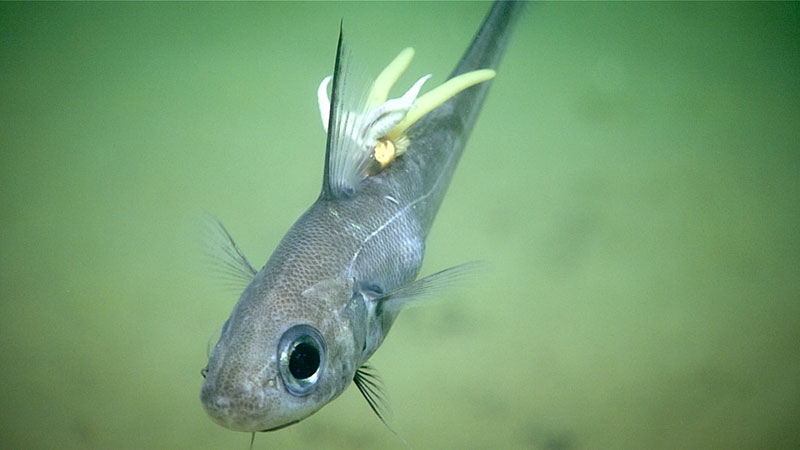
A rattail was seen during Dive 16 of Windows to the Deep 2019 with a parasitic copepod (yellow) that had parasitic leeches (white) on top. Image courtesy of the NOAA Office of Ocean Exploration and Research, Windows to the Deep 2019. Download larger version (jpg, 862 KB).
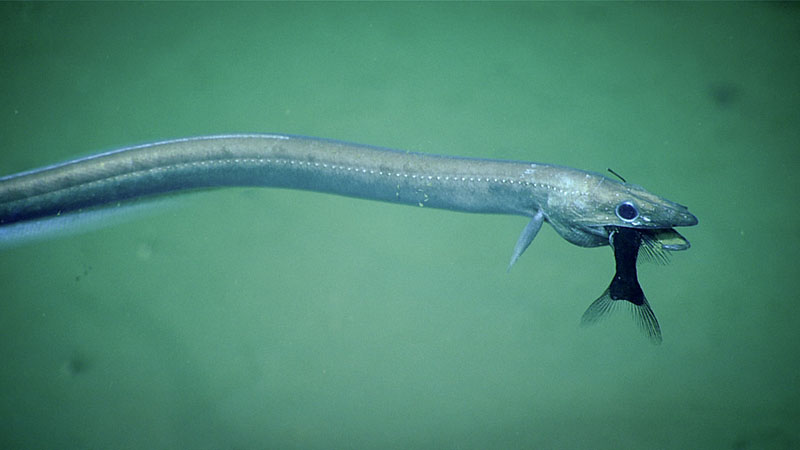
This synaphobranchid eel was documented preying on a fish during Dive 16 of the Windows to the Deep 2019 expedition. Image courtesy of the NOAA Office of Ocean Exploration and Research, Windows to the Deep 2019. Download larger version (jpg, 1.0 MB).
The dive began at around 991 meters (3,251 feet) depth, near the bottom of the canyon wall on a soft, sedimented seafloor. As we traversed toward the canyon wall, there were a number of cutthroat eels (Synaphobranchidae), red crabs (Chaceon sp.), short-finned squid (Illex sp.), and rattails (Nezumia sp.). These were the primary organisms observed for much of the dive over the soft, silty bottom. We saw a number of rattails with parasites (parasitic copepods and isopods) and one rattail was seen with a parasitic copepod that had parasitic leeches. There were also many white tubes in the sediment that were suggested to be polychaete tubes. We made a collection of these tubes around 820 meters (2,690 feet) to help with this identification. We also observed multiple mating pairs of Chaceon red crabs.
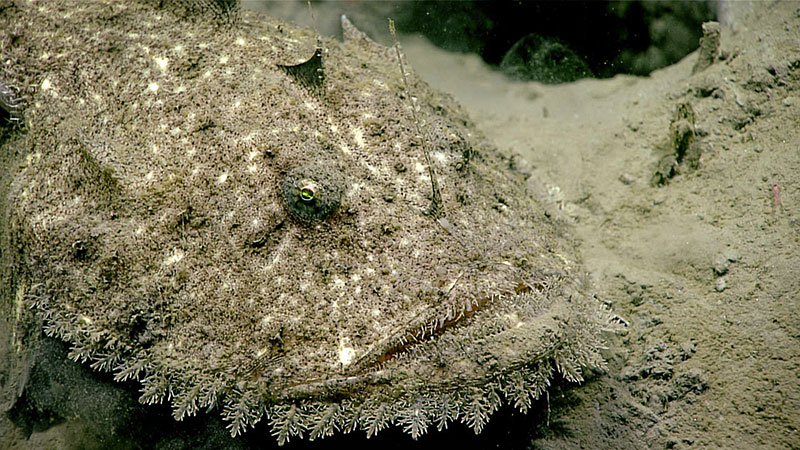
This monkfish was hard to spot camouflaged against the seafloor around 861 meters (2.825 feet) depth during Dive 16 of the Windows to the Deep 2019 expedition. Image courtesy of the NOAA Office of Ocean Exploration and Research, Windows to the Deep 2019. Download larger version (jpg, 1.8 MB).
A rocky outcrop began around 930 meters (3,051 feet) depth. This outcrop had a number of small sponges, anemones, and cup corals (Desmophyllum dianthis) attached to the hard surface. A couple of types of flat fishes and rays were also seen in and around the rocky surface, including a juvenile witch flounder (Glyptocephalus sp.), deepsea batfish (Ogcocephalidae), and monkfish (Lophius sp.). Beyond the rocky outcrop was more highly sedimented seafloor and semi-consolidated mud/clay with many red crabs and squat lobsters in burrows. The dive ended at around 463 meters (1,519 feet) as escalating weather conditions dictated an early recovery of the remotely operated vehicle.
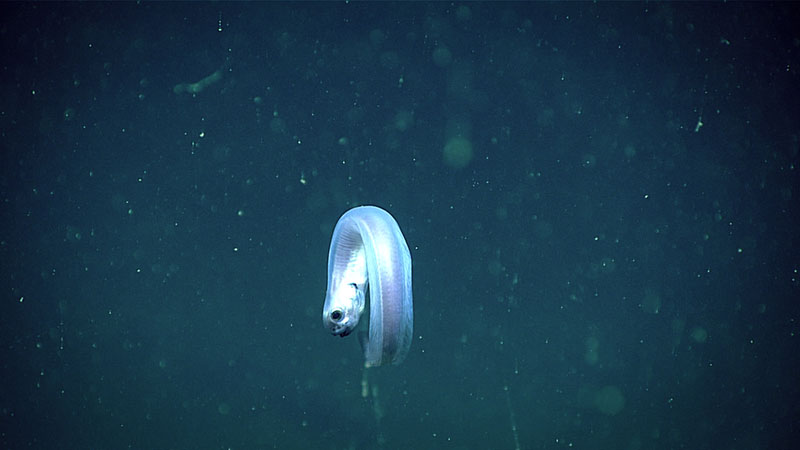
This unidentified fish was seen displaying an interesting behavior in the water column at the start of Dive 16 for the Windows to the Deep 2019 expedition. Image courtesy of the NOAA Office of Ocean Exploration and Research, Windows to the Deep 2019. Download larger version (jpg, 957 KB).

Location of Dive 16 on July 8, 2019. Download larger version (jpg, 2.3 MB).
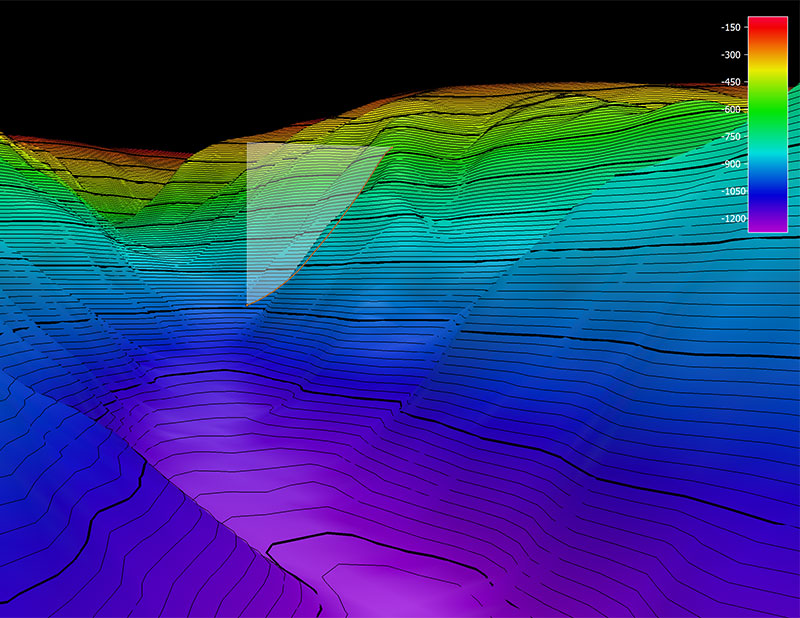
The remotely operated vehicle track for Dive 16, shown as an orange line with a white curtain. Scale is water depth in meters. Download larger version (jpg, 4.4 MB).